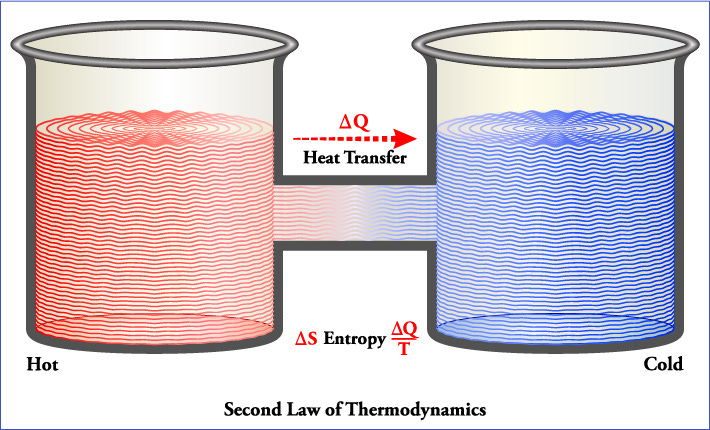Exception to laws of thermodynamics
A team of researchers led by a physics graduate student recently made the surprising discovery of what they call a 'shape-recovering liquid,' which defies some long-held expectations derived from the laws of thermodynamics. The research details a mixture of oil, water and magnetized particles that, when shaken, always quickly separates into what looks like the classically curvaceous lines of a Grecian urn.
Sponsored by Great Learning
Gain cutting-edge skills in AI and Data Science with Great Learning Academy Premium, featuring guided projects, top faculty, and AI Mentor to boost your career success.
Gain workplace-ready skills in AI and Data Science with application-driven learning. Learn from top industry experts, work on hands-on projects and interactive coding exercises. Get 24/7 personalized AI mentorship and AI-led mock interview prep. Limited time 50% OFF — now starting at just $40.
New research boosts future whooping cough vaccines
New research could aid in improving whooping cough vaccines to once again push this disease toward eradication by targeting two key weaknesses in the infection.
An antiviral chewing gum to reduce influenza and herpes simplex virus transmission
Low vaccination rates for influenza viruses and the lack of an HSV vaccine underscore the need for a new approach to reduce viral transmission. Researchers have now used a clinical-grade antiviral chewing gum to substantially reduce viral loads of two herpes simplex viruses and two influenza A strains in experimental models.
No bones about it: New details about skeletal cell aging revealed
Scientists and researchers around the globe are investigating a series of mysteries about what happens to our bones over time.
Researchers reveal why young plants may be more vulnerable to disease
A new study reveals an evolutionary trade-off that young plants face to develop disease resistance.
Best methods for growing Atlantic sea scallops
A new study compares two scallop farming methods, ear-hanging and lantern net culture, over a complete grow-out cycle to determine which approach yields the best results for commercial growers. The study found that scallops grown with ear-hanging culture had slightly larger shell heights, about 1-4% greater than those in lantern nets. More significantly, ear-hanging scallops had up to 12% more adductor muscle weight. Researchers also found that ear-hanging scallops grew more quickly in optimal conditions, which are between 50 and 59 degrees Fahrenheit, but were more affected by colder winter temperatures than those in lantern nets.
Oxygen is running low in inland waters, and humans are to blame
Rivers, streams, lakes, and reservoirs aren't just scenic parts of our landscape -- they're also vital engines for life on Earth. These inland waters 'breathe' oxygen, just like we do. But a new study shows that we've been suffocating them during the last century, an era also known as the Anthropocene. The research reveals that the way oxygen is produced and used in inland waters has dramatically changed since 1900. The culprit? Human activities.
A cohort study was conducted in Spain to compare the health and environmental benefits of the Planetary Health Diet (PHD) and the Mediterranean Diet. Compared to participants with low adherence, higher adherence to both diets was similarly associated with lower all-cause mortality and with comparable low environmental impact. This study highlights the advantages of the plant-based diets, with wider adoption of healthy and sustainable diets needed to prevent excess premature deaths worldwide.
Hot Schrödinger cat states created
Quantum states can only be prepared and observed under highly controlled conditions. A research team has now succeeded in creating so-called hot Schrodinger cat states in a superconducting microwave resonator. The study shows that quantum phenomena can also be observed and used in less perfect, warmer conditions.
Novel genomic screening tool enables precision reverse-engineering of genetic programming in cells
Collaborative research defines a novel approach to understanding how certain proteins called transcription factors determine which genetic programs will drive cell growth and maturation. The method, called 'Perturb-multiome,' uses CRISPR to knock out the function of individual transcription factors across many blood cells at once. The researchers then perform single-cell analyses on each cell to measure the effects of the editing, including identifying which genes have been turned on or off and which genes are accessible (based on epigenetic markers).
Signs identified that precede sudden arrhythmic death syndrome in young people
A retrospective observational study found that 22% of cases of sudden cardiac death were due to sudden arrhythmic death syndrome (SADS). Syncope, seizure-like episodes and changes in electrocardiograms were common signs that preceded SADS. Identifying these signs is important during healthcare visits and also during preparticipation screening of young athletes, which should be implemented more widely.
Century-old clues reveal hidden threat to Australian songbird
A hidden threat facing one of Australia's most iconic birds has been uncovered in a new study. The critically endangered regent honeyeater once numbered in the hundreds of thousands, but their population has dwindled to fewer than 300. By analysing the DNA of museum specimens more than 100 years old and comparing it to modern samples, the team discovered that despite a population decline of 99 per cent, this has not been entirely mirrored by genetics. The bird has lost 9 per cent of its genetic diversity.
A Leap in viral research: More sensitive viral RNA detection
Researchers have unveiled innovative, label-free ratiometric fluorosensor designed for the selective and sensitive detection of enteroviral RNA. The research promises to deliver even more advanced and effective detection methods, reinforcing the importance of interdisciplinary collaboration in addressing global health challenges.
Molecular stool test could improve detection of tuberculosis in adults with HIV
The Xpert MTB/Ultra molecular diagnostic test for stool samples, until now recommended only for children, could be established as an additional test for diagnosing tuberculosis in adults living with HIV.
Suspected fibrocartilaginous embolus in Asian small-clawed otter (Aonyx cinereus)
A research team investigated the case of a male Asian small-clawed otter that fell down the stairs while sleeping, after which it developed left-sided paralysis.
Astronomers discover doomed pair of spiralling stars on our cosmic doorstep
Astronomers have discovered an extremely rare, high mass, compact binary star system only ~150 light years away. These two stars are on a collision course to explode as a type 1a supernova, appearing 10 times brighter than the moon.
Soil conditions significantly increase rainfall in world's megastorm hotspots
Storm forecasting is traditionally based on studying atmospheric conditions but ground-breaking research that also looks at land surface conditions is set to transform early warning systems in tropical regions. This will enable communities to better adapt to the destructive impacts of climate change. The new study has shown that a large contrast in soil moisture levels over a range of hundreds of kilometers results in atmospheric changes that increase rainfall area and amount in several megastorm hotspots globally. This increase ranges from 10 to 30% depending on the region and size of the storm.
NK cells complexed with bispecific antibody yield high response rates in patients with lymphoma
A novel cell therapy approach using cord blood-derived natural killer (NK) cells pre-complexed with AFM13, or acimtamig, a CD30/CD16A bispecific antibody, was safe and generated strong response rates for patients with refractory CD30-positive lymphomas, according to a new study.
Discovery of bacteria's defense against viruses becomes a piece of the puzzle against resistance
Antibiotic resistance is a global health challenge that could overtake cancer mortality within a few decades. In a new study, researchers show that the emergence of resistance can be understood in the mechanism of how bacteria build up defenses against being infected by viruses. It is about genes in the bacterium that interfere with the attacking virus's ability to multiply.
How can science benefit from AI? Risks?
Researchers from chemistry, biology, and medicine are increasingly turning to AI models to develop new hypotheses. However, it is often unclear on which basis the algorithms come to their conclusions and to what extent they can be generalized. A publicationnow warns of misunderstandings in handling artificial intelligence. At the same time, it highlights the conditions under which researchers can most likely have confidence in the models.
Fear of rejection influences how children conform to peers
The fear of rejection -- familiar to many children and adults -- can significantly impact how kids behave in their peer groups, according to new research.
Polymers with flawed fillers boost heat transfer in plastics
In the quest to design the next generation of materials for modern devices -- ones that are lightweight, flexible and excellent at dissipating heat -- a team of researchers made a discovery: imperfection has its upsides.
Outdoor time and multisport activities develop children's motor competence
A study followed the development of children's motor skills over a three-year period, from early childhood education to school age. The study showed that independent outdoor time and multisport activities support the development of motor competence. Even 30 minutes of outdoor time after a day at childcare makes a difference.
Artificial intelligence has potential to aid physician decisions during virtual urgent care
Do physicians or artificial intelligence (AI) offer better treatment recommendations for patients examined through a virtual urgent care setting? A new study shows physicians and AI models have distinct strengths. The study compared initial AI treatment recommendations to final recommendations of physicians who had access to the AI recommendations but may or may not have reviewed them.
How a small number of mutations can fuel outbreaks of western equine encephalitis virus
New research shows how small shifts in the molecular makeup of a virus can profoundly alter its fate. These shifts could turn a deadly pathogen into a harmless bug or supercharge a relatively benign virus, influencing its ability to infect humans and cause dangerous outbreaks.
Exposure to wildfire smoke linked with worsening mental health conditions
Exposure to fine particulate air pollution (PM2.5) from wildfire smoke was associated with increased visits to emergency departments (ED) for mental health conditions, according to a new study.
Research uncovers hidden spread of one of the most common hospital-associated infections
C. difficile (C. diff) is one of the most common and contagious hospital-acquired infections. Research has found that C. diff spreads more than three times more than previously thought. C. diff can spread covertly from surface to surface and remain undetected for weeks until it infects a patient. The results could spur more rigorous preventive measures that stop hidden spread of the disease.
Pancreatic cells 'remember' epigenetic precancerous marks without genetic sequence mutations
Scientists say they have found a pattern of so-called epigenetic 'marks' in a transition state between normal and pancreatic cancer cells in mice, and that the normal cells may keep at least a temporary 'memory' of those cancer-linked marks.
Exercise as an anti-aging intervention to avoid detrimental impact of mental fatigue
Retired adults who habitually exercised outperformed sedentary adults in physical and cognitive tests.





